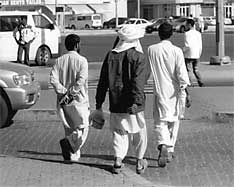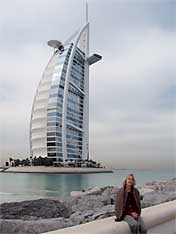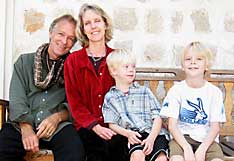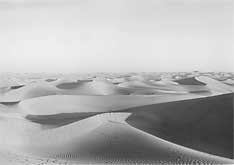A Writer Writes: Living in the UAE
In August of 2008 Darcy Munson Meijer (Gabon 1982-84) moved to Abu Dhabi with her husband and two of her children, boys ages 7 and 8, to begin a three-year teaching contract at Zayed University, an all-female institution. She went to work in the Academic Bridge Program that prepares the women to do university coursework full-time in English.
Darcy explains the reason for this essay . . .
It started at the annual party hosted by one of my fellow Gabon RPCVs in St. Croix last summer — this desire to set people straight about life in Abu Dhabi. While my friends were sharing stories and gossip in the corps de garde, conversation turned to the birqa that I would surely have to wear in the United Arab Emirates, where we to move shortly. You may already know that the surest way to get an American’s knickers in a wad is to mention feminine Arab headwear. It spells lack of freedom to my compatriots, but in simplifying so, they are missing the culture behind the veil. My purpose in writing is not to defend the style of dress in the UAE, however. I just want to paint a picture of the country and let people know how enjoyable life can be in the Arabian Gulf.”
• • •
Living in the United Arab Emirates
Abu Dhabi is one of 7 emirates which make up the United Arab Emirates. The others are Dubai, Sharjah, Um al Qawain, Fujairah, Ajman and Ras al Khaima. The UAE is bordered in the east by Oman and in the west and south by Saudi Arabia. It is on the Arabian Gulf. Other neighbors on the Arabian Peninsula are Qatar, Bahrain, Yemen and Kuwait. The UAE is all desert except for scattered oases. However, a few cities like Abu Dhabi, Al Ain and Dubai are busy and cosmopolitan.
The city of Abu Dhabi is the capital of the UAE. It is located in the emirate of the same name — Abu Dhabi — the largest and most populous of the seven. Abu Dhabi has a love-hate relationship with Dubai. One could say Dubai is like Las Vegas, a gilt city in the desert, ebulliantly expanding with little regard for its Muslim foundation or the environment, while Abu Dhabi is the proud, traditional cousin. The name Abu Dhabi means “Father of the Gazelle.” The story has it that when nomadic tribes first came to the island, they saw a big herd of gazelles and honored them with the name.
We live on the top (12th) floor of an apartment building close to campus. It’s a 15-minute walk for me, and on the way I pass

Abu Dhabi street scene
the bus/taxi stand, many little shops, a simple mosque, and numerous tall apartment buildings. Our building is on the “Dubai Highway,” as it runs straight to Dubai — two hours to the northeast. It’s a major four-way intersection, and cars screech their brakes in frustration at the short-lasting yellow lights. One of the few things I don’t like about the UAE is the high car accident rate. Emiratis are careless drivers. They blame the accidents on the

Marcy at the Arab Tower (Burl Al-Arab) in Dhubai
Bangladeshi and Pakistani taxi drivers, but the statistics say it’s young Emirati men with expensive sports cars and time on their hands.
I like my job here. The University provides great benefits and salary. We have a lovely, spacious apartment, all white and gray marble with big softly-tinted windows in every room. My students — Emirati women between 18 and 24 — are delightful to work with. They’re funny, sociable, and quick but not at all academically diligent. Love of negotiation must be a genetic trait with them, and I’ve had to learn this to win their support. They ask, “Can we change the grammar test to Tuesday?” I reply, “Yes, but then you have to turn in the essay first thing tomorrow.” This is not just about dates and quizzes, but about my willingness to discuss it with them, to make a deal everyone is happy with. Home life is the biggest priority for the women. Most of them plan to marry after university, have a part-time job and raise children.
There are mosques, big and small, all over Abu Dhabi. The minarets are lit up bright green at night — a holy color in Islam. Ramadan began September 1 last year, and it’s a holiday Muslims hold close to their hearts. As you may know, it is absolutely forbidden for healthy people over the ages of 10–12 to eat, drink, chew gum or smoke in public from sunup to sundown. Teachers couldn’t eat in our offices. Instead, the faculty workroom was set aside for non-Muslim teachers for lunch. The blinds were drawn, and we brought in our politely covered lunch bags and coffee mugs and closed the door. In class, students were dressed and behaved more modestly than usual.
I asked the women whether they found it hard to fast, but they said no since it shows their love for God and purifies them. I asked if anybody cheats, and after consulting one another, they agreed that some people think they are cheating, but nobody cheats God.
Emirati women wear abayas (long black robes) in public, the stylish ones embroidered and jeweled on the sleeves and hems. As far as headwear, some women are totally covered, a veil over the face. Others look out through narrow slits over the eyes. Most wear sheylas, open-faced headscarves. I rarely see birqas, the masks that cover nose, brow and mouth, except on a few older, married women. Even among girls who don’t wear it normally in public, there’s social pressure to wear the abaya at the University. When the students are relaxed in class, you can see, underneath them, long colorful skirts or faded jeans, low-cut blouses and sparkly high heels. Most of the women have very long hair, and they pile it on their heads, making the sheyla sit high up. They glide around the campus gardens talking into mobile headphones or sit in big groups, laughing and shouting.
Though the UAE has grown at a fantastic rate since 1972 and is one of the most relaxed Muslim countries for a non-Muslim to live in, it is still quite traditional. Males have to knock before entering a classroom to give the women a few seconds to cover themselves. Male teachers CANNOT touch the students. If a student is choking or on the floor with a heart attack, he must call a female teacher or campus security. It’s polite for a woman not to initiate a handshake with an Emirati man, but to wait for him to offer his hand first. Female teachers are asked to respect local custom by not wearing dresses or skirts above the knee, or short sleeves or low-cut tops.
Icons of the UAE are the falcon, horse, camel, dhow, and palm tree. Henna is also quite popular. Most of my students have beautiful henna designs applied to their hands and feet several times a year, in reddish brown or black. It wears off within two weeks, unlike my 19-year-old daughter’s new tattoo. Alas: the price of freedom.

The Meijer family
We have taken advantage of our location to travel to countries in the area. We first visited Oman, an amazing desert-scape of black rock mountains and its striking port and capital — Muscat. During fall break, we photographed ourselves at the Taj Mahal, Delhi and the Red Fort in India. A co-worker and I spent 4 days in the ancient Nabadean town carved out of rock — Petra — in Jordan. Our final trip this year was to Istanbul, Turkey. A major boon in these travels was the opportunity to compare Arabs in these different places. Their dress, their customs, their food, their history — all are different.
The founder and former president of the UAE, Sheikh Zayed bin Sultan Al Nahyan, was truly and personally loved by Emiratis. He was smart, ethical and forward-thinking, recognized by leaders in the region as a great president who did much for the country and for Arabic unity. It was he who brought together the 7 emirates in one federation in 1971. He, too, who supported Egypt and Syria in 1973 by being the first nation to impose an oil embargo on the West. He died in 2004, and his son, Sheikh Khalifa bin Zayed Al Nahayan, is now president.
 Mohammed Al-Fahim‘s From Rags to Riches, A Story of Abu Dhabi, tells how the UAE —known as the “Trucial States” until Britain finally relinquished its 170-year economic stranglehold on the area in 1968 — discovered oil in the ’50s, tapped and sold it in the ’60s, and blossomed into statehood with Sheikh Zayed in the 1970s. As the writer says, “The country went from no tech to high tech in just a few years.” Fortunately, the current leaders have recognized that UAE oil resources will last only until late in this century, at the current rate of exploitation, and they are already broadening the nation’s money base — diversifying the portfolio — and developing alternative energy capacity with solar and wind power.
Mohammed Al-Fahim‘s From Rags to Riches, A Story of Abu Dhabi, tells how the UAE —known as the “Trucial States” until Britain finally relinquished its 170-year economic stranglehold on the area in 1968 — discovered oil in the ’50s, tapped and sold it in the ’60s, and blossomed into statehood with Sheikh Zayed in the 1970s. As the writer says, “The country went from no tech to high tech in just a few years.” Fortunately, the current leaders have recognized that UAE oil resources will last only until late in this century, at the current rate of exploitation, and they are already broadening the nation’s money base — diversifying the portfolio — and developing alternative energy capacity with solar and wind power.
From ancient times until the 1960s, the primary sources of income in this part of the Gulf were fishing, goat and camel trading, and pearl diving. The staple diet was rice, fish, dates and camel’s milk. Many Emirati tribes were still nomadic — Bedouin or “Bedu” — following good pasturage for their herds. Town dwellers lived in barasti (woven palm fronds and mud  huts), and their children attended Quran school for a few years if their families could spare them. Abu Dhabi
huts), and their children attended Quran school for a few years if their families could spare them. Abu Dhabi

Desert sunrise in the Emirates
families lived here most of the year but summered at the Liwa and Al Ain oases, where it is cooler. We visited Liwa and looked upon a part of the famous “Empty Quarter” — Rub al Khali — the vast uninhabited desert described so well by William Thesiger in Arabian Sands.
The arts are vigorously promoted here. Two goals of the Ministry of Culture are to make the UAE a well-known arts venue and revitalize the grandeur of Arabia’s Golden Age, so there is a lot to offer here. During our first week we saw a Picasso exhibit and bought season tickets to the European Film Festival. The Abu Dhabi Cultural Foundation has a team of scholars translating hundreds of literature classics from all over the world into Arabic. We heard a gypsy band from Serbia, the French/Sufi ensemble “Badila,” and saw the film “Some Kind of Monster” about the psychotherapy undergone by the  supergroup “Metallica.” Last week we attended a music and dance extravaganza from the steppes of Kazakhstan at the Emirate’s Palace, where photos by Henri Cartier-Bresson were also on display. My husband heard Catherine Deneuve speak there in January and brought the boys to the world premiere of the film Ibn Batuta, about the 14th century Moroccan explorer of Arabia.
supergroup “Metallica.” Last week we attended a music and dance extravaganza from the steppes of Kazakhstan at the Emirate’s Palace, where photos by Henri Cartier-Bresson were also on display. My husband heard Catherine Deneuve speak there in January and brought the boys to the world premiere of the film Ibn Batuta, about the 14th century Moroccan explorer of Arabia.
In December we drove an hour out of town to a regional camel race, auction and festival. We watched hundreds of vendors auctioning off their camels and sat in on camel beauty contests. Among the criteria? Straight limbs, shiny coats and firm ears. We’ve tried camel’s milk, too, which is sweet and yogurty at the same time. It’s rich in vitamin C, and some people drink it for its anti-constipation properties.
We are lucky to have, in our neighborhood, two Indian diners, a Lebanese bakery and restaurant, and Syrian and Korean restaurants. All of them serve great food. We also have a Starbucks and a Baskin-Robbins which, out of loyalty to our new Middle East home and our taste buds, we don’t patronize.
I became aware of world politics in the late 1960s, right in time to hear about the 1967 Arab-Israeli War. Then came the oil embargo in 1973, with Americans crying foul at the gas tanks. In 1979 Iran, the Islamic Revolution deposed the Shah and installed the anti-American Ayatollah Khomeini. Charles Freeman, in his recent withdrawal from the nomination to be President Obama’s Chairman of the National Intelligence Council, lamented the power of the Israel lobby over the government: “We Americans cannot any longer conduct a serious public discussion or exercise independent judgment about matters of great importance to our nation, allies or friends.” We live with a burden of prejudice instilled in us by our foreign policy makers, our history books, the media and our compatriots.
To put it in perspective, the United Arab Emirates is a small, young country in the Gulf. What is widely considered to be the “Arab World” comprises 24 countries and 325 million people. This region was home to ancient Babylonia, Assyria, Sumeria, Egypt and Mesopotamia, not to mention dramatic survivors like Istanbul, Damascus, Giza, Jericho and Fez. How can the whole region be lumped into one maligned category?
As a Peace Corps Volunteer, I was praised for helping the poor Gabonese. It didn’t matter much to friends and family at home that the majority of Gabonese are not Christian, that they practice some very harsh rituals, that they are basically tribal in affiliation, that the women go bare-breasted and many families still live in mud houses. “Africa” elicits sympathy whereas “Arabia” brings out sarcasm and hostility.
As those of you who worked with the Peace Corps know, when you are in a country you see its uniqueness and grow to appreciate it. You change under its influence. The notion “Practice Tolerance” should be understood anew. If we “practice” tolerance as we practice any skill, our ability to do so increases. We begin by questioning our opinions about other countries. We learn a little about the place, and our interest grows. I look forward to living in the UAE for several more years; it’s great to be part of a young and promising Arab nation.
Dear Darcy Munson Meijer–
I hope you have a book in mind, down the road.
Jack Prebis Ethiopia ’62-’64, ’65-’67
Hi Darcy,
I sent you a xmas card to TN but it got returned to sender. Now I see why.